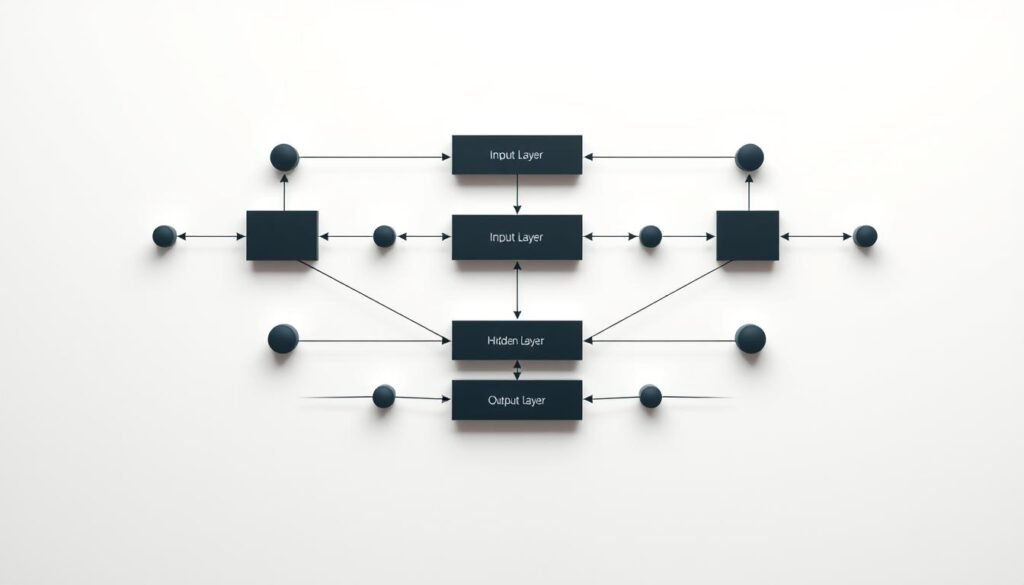TensorFlow for Deep Learning empowers developers and researchers to harness the full potential of multi-layered neural networks—one of the most powerful techniques in modern machine learning. These networks, inspired by the structure of the human brain, enable machines to identify patterns, interpret complex data, and make intelligent decisions.
What sets deep learning apart is its use of multiple layers, each learning to detect increasingly abstract features from the data. With TensorFlow, building and training these deep neural networks becomes more accessible and efficient, streamlining everything from model architecture to deployment.
In this article, we’ll guide you through the process of using TensorFlow for Deep Learning—covering foundational concepts and practical steps to help you construct and train your own neural network from scratch.
Key Takeaways
- Deep learning is a subset of machine learning focused on multi-layered neural networks.
- Neural networks mimic the human brain to process and analyze data.
- Multiple layers in a network enhance feature extraction and accuracy.
- TensorFlow simplifies the creation and training of neural networks.
- This article provides practical steps to build and train a neural network.
Introduction to Deep Learning with TensorFlow
TensorFlow has become a cornerstone in the world of machine learning. Its ability to simplify complex tasks makes it a favorite among developers and researchers. Whether you’re working on a small project or a large-scale deployment, TensorFlow provides the tools you need to succeed.
At its core, TensorFlow is designed to handle neural networks efficiently. These networks are the backbone of many modern applications, from image recognition to natural language processing. By breaking down tasks into layers, TensorFlow ensures that each step is optimized for performance.
Before diving into building models, it’s essential to understand key terms. A datum refers to a single piece of information, while a model is the structure that processes this data. TensorFlow excels at managing both, making it a versatile choice for various projects.
One of TensorFlow’s strengths is its scalability. Whether you’re prototyping a new idea or deploying a full-scale solution, the framework adapts to your needs. This flexibility is why TensorFlow is widely used in both academic and industrial settings.
Understanding the underlying network structures is crucial before constructing a neural network. TensorFlow provides the resources to explore these structures, ensuring you can build models that are both efficient and effective.
Understanding Neural Networks and Their Architectures
The architecture of neural networks plays a crucial role in solving advanced machine learning problems. These networks are designed with multiple layers, each contributing to the extraction of meaningful features from data. This layered structure is what makes them “deep,” enabling them to handle complex tasks like image recognition and natural language processing.
Early neural networks were simple, with only a few layers. They struggled with tasks requiring high levels of abstraction. Modern architectures, however, use dozens or even hundreds of layers. This depth allows them to learn intricate patterns and make accurate predictions.
Every neural network consists of three main components: input, hidden, and output layers. The input layer receives raw data, while the hidden layers process it through weighted connections. Finally, the output layer provides the result, such as a classification or prediction.
For example, in image recognition, the first hidden layer might detect edges, while deeper layers identify shapes and objects. This progressive feature extraction is what makes deep architectures so powerful.
| Aspect | Early Neural Networks | Modern Neural Networks |
|---|---|---|
| Number of Layers | Few (1-3) | Many (dozens to hundreds) |
| Feature Extraction | Basic patterns | Complex patterns |
| Applications | Simple tasks | Advanced tasks (e.g., image recognition) |
Understanding these architectures is essential for building effective models. Whether you’re working on machine vision or predictive analytics, the right structure can make all the difference.
Preparing Your TensorFlow Environment
Setting up your TensorFlow environment is the first step toward building powerful machine learning models. A properly configured computer ensures smooth integration and optimal performance for your projects. Whether you’re a beginner or an experienced developer, following these steps will help you get started quickly.
First, ensure your system meets the hardware requirements. For learning deep learning tasks, a GPU is highly recommended. GPUs accelerate computations, making them ideal for training complex models. If you don’t have a GPU, TensorFlow can still run on a CPU, but performance may be slower.
Next, install TensorFlow using Python, the primary language for machine learning. Use the following command to install the latest version:
pip install tensorflow
Complementary libraries like NumPy, Pandas, and Matplotlib are also essential. These tools help with data manipulation, analysis, and visualization. Install them alongside TensorFlow to create a robust development environment.
Here are some best practices to follow:
- Use virtual environments to manage dependencies and avoid conflicts.
- Regularly update TensorFlow and its libraries to access the latest features.
- Configure your GPU drivers and CUDA toolkit for optimal performance.
Common pitfalls include incompatible library versions and missing dependencies. If you encounter errors, check the TensorFlow documentation or community forums for troubleshooting tips.
Finally, verify your installation by running a simple test program. This ensures everything is set up correctly and ready for application development. A successful test confirms your environment is prepared for building and training neural networks.
Deep Learning Fundamentals: Concepts and Techniques
Understanding the core concepts of deep learning is essential for mastering its techniques. At its heart, deep learning relies on neural network architectures that mimic the human brain. These architectures process data through multiple layers, extracting meaningful patterns and features.
One of the key components in deep learning is the activation function. It determines whether a neuron should be activated, helping the network learn complex relationships. Common activation functions include ReLU, Sigmoid, and Tanh, each suited for specific tasks.

Another critical concept is loss computation. This measures how well the model performs by comparing its predictions to the actual data. Techniques like Mean Squared Error (MSE) and Cross-Entropy Loss are widely used to optimize models.
Backpropagation is the backbone of training neural networks. It adjusts the weights of the network by calculating the gradient of the loss function. This iterative process helps the model improve its accuracy over time.
Deep learning differs from traditional machine learning in its architecture and function. While traditional methods rely on handcrafted features, deep learning automates feature extraction through its layered structure. This makes it more effective for tasks like natural language processing and computer vision.
| Aspect | Traditional Machine Learning | Deep Learning |
|---|---|---|
| Feature Extraction | Manual | Automatic |
| Data Processing | Limited to structured data | Handles unstructured data (e.g., images, text) |
| Applications | Basic predictive tasks | Advanced tasks (e.g., natural language processing) |
Deep neural networks excel at processing vast amounts of data. For example, in natural language processing, they can analyze text to understand sentiment or translate languages. Similarly, in computer vision, they can identify objects in images with high accuracy.
To dive deeper into these concepts, explore our guide on deep learning neural networks. This resource provides a comprehensive overview of architectures, data preparation, and optimization techniques.
Step-by-Step Guide to Building a Neural Network
Building a neural network involves a structured approach, from data preparation to model evaluation. Each step is crucial for creating a model that performs well in real-world applications. Whether you’re working on natural language processing or computer vision, this guide will walk you through the process.
Gathering and Preparing Data
The first step is gathering and preparing your dataset. High-quality data is essential for training effective models. Start by sourcing datasets relevant to your field, such as text for natural language tasks or images for computer vision.
Once you have your data, clean it to remove inconsistencies. This might involve removing duplicates, handling missing values, or normalizing data. Clean data ensures your model learns accurate patterns.
Finally, split your data into training, validation, and test sets. This helps evaluate your model’s performance effectively. Use techniques like shuffling to ensure randomness and avoid bias.
Constructing the Model Layers
Next, design the architecture of your neural network. Start with the input layer, which receives your prepared data. Then, add hidden layers to process the data through weighted connections.
Each layer should use an appropriate technique for feature extraction. For example, convolutional layers are ideal for image data, while recurrent layers work well for sequential data like text.
Finally, configure the output layer to provide the desired result, such as a classification or prediction. The structure of your layers will depend on the complexity of your task.
Implementing Training and Evaluation
Training your model involves forward propagation, backpropagation, and optimization. Forward propagation passes data through the network, while backpropagation adjusts weights based on errors.
Optimization techniques like gradient descent help minimize the loss function. This ensures your model improves over time. Monitor metrics like accuracy and loss to evaluate performance.
Here’s a comparison of data preparation techniques:
| Technique | Purpose | Example |
|---|---|---|
| Normalization | Scale data to a standard range | Rescaling pixel values to 0-1 |
| Tokenization | Break text into smaller units | Splitting sentences into words |
| Augmentation | Increase dataset size | Flipping images horizontally |
By following these steps, you can build a neural network that mimics the human brain’s ability to process complex data. Whether you’re a beginner or an expert, this guide provides a clear path to success.
Building and Training Your Neural Network Model
Building and training a neural network model requires a clear understanding of its architecture and training techniques. A well-structured model ensures efficient data processing and accurate results. This section will guide you through defining the layers and using propagation techniques to enhance your model’s performance.
Defining Input, Hidden and Output Layers
The foundation of any neural network lies in its layers. The input layer receives raw data, such as text for language processing or frames from a video. This layer acts as the entry point for information.
Hidden layers process the data through weighted connections. Each layer extracts specific features, enhancing the model’s ability to identify patterns. For example, in a deep learning model, the first hidden layer might detect edges in an image, while deeper layers recognize shapes.
The output layer provides the final result, such as a classification or prediction. Its structure depends on the task, whether it’s identifying objects in a video or translating text for language processing.
Using Backpropagation and Forward Propagation
Forward propagation is the process of passing data through the network. It starts at the input layer and moves through each hidden layer until it reaches the output. This step generates predictions based on the current weights of the model.
Backpropagation corrects errors by adjusting these weights. It calculates the gradient of the loss function and updates the weights to minimize errors. This iterative process improves the model’s accuracy over time.
Here’s a comparison of these techniques:
| Aspect | Forward Propagation | Backpropagation |
|---|---|---|
| Purpose | Generate predictions | Correct errors |
| Direction | Input to output | Output to input |
| Role in Training | Process data | Optimize weights |
By combining these techniques, you can build a deep learning model that learns efficiently and delivers accurate results. Whether you’re working on language processing or analyzing video data, these methods are essential for success.
Optimizing and Fine-Tuning Your Network
Optimizing your neural network is a critical step to ensure it performs efficiently and delivers accurate results. Fine-tuning involves adjusting various components of your learning model to achieve the best possible outcomes. This section explores strategies for hyperparameter tuning, performance evaluation, and troubleshooting common issues.
Hyperparameter Tuning
Hyperparameters are settings that control the training process of your learning model. These include learning rate, batch size, and the number of layers. Proper tuning can significantly improve performance.
Start by experimenting with different values for these parameters. Use techniques like grid search or random search to identify the optimal combination. For example, a lower learning rate might prevent overshooting, while a larger batch size can speed up training.
Performance Evaluation Techniques
Evaluating your model’s performance is essential to ensure it meets your goals. Key metrics include loss and accuracy. Loss measures the difference between predicted and actual values, while accuracy indicates how often the model is correct.
Use validation sets to monitor progress during training. This helps detect overfitting, where the model performs well on training data but poorly on new data. Regularly check these metrics to refine your system.
Troubleshooting Common Issues
Training a neural network can sometimes lead to unexpected challenges. One common issue is vanishing gradients, where updates to weights become too small to improve the model. To resolve this, consider using activation functions like ReLU.
Another issue is overfitting, which can be addressed by adding dropout layers or increasing the size of your dataset. Monitoring your hidden layer outputs can also help identify where the model might be struggling.
Here’s a comparison of common issues and solutions:
| Issue | Solution |
|---|---|
| Vanishing Gradients | Use ReLU activation |
| Overfitting | Add dropout layers |
| Slow Training | Increase batch size |
By following these strategies, you can fine-tune your network for tasks like computer vision or natural language processing. Regular monitoring and adjustments ensure your model remains efficient and effective.
Leveraging Key TensorFlow Tools and Techniques
TensorFlow offers a suite of tools that simplify the development of advanced machine learning models. These tools streamline the process of building, training, and optimizing artificial neural networks, making it easier to achieve high-performance results. Whether you’re working on recognition tasks or complex data analysis, TensorFlow’s ecosystem provides the resources you need.

Utilizing the Keras API
The Keras API is a powerful tool for building neural networks quickly and efficiently. Integrated with TensorFlow, Keras simplifies model creation by providing a high-level interface. This allows developers to focus on designing the architecture rather than managing low-level details.
For example, you can define layers, activation functions, and optimizers with just a few lines of code. This flexibility makes Keras ideal for both beginners and experienced developers working on diverse tasks.
Monitoring with TensorBoard
TensorBoard is an essential tool for visualizing and monitoring your model’s performance. It provides real-time insights into metrics like loss and accuracy, helping you identify areas for improvement. By tracking these metrics, you can fine-tune your model to achieve better results.
Additionally, TensorBoard allows you to visualize the input data flow through the network. This helps you understand how each layer processes information, making it easier to debug and optimize your model.
Here’s a comparison of TensorFlow tools:
| Tool | Purpose |
|---|---|
| Keras API | Simplifies model creation |
| TensorBoard | Visualizes performance metrics |
By leveraging these tools, you can enhance your model’s recognition capabilities and streamline your workflow. Whether you’re working on image classification or natural language processing, TensorFlow’s ecosystem ensures you have the right tools for the job.
Practical Applications of Machine Learning and Neural Networks
From healthcare to finance, neural networks are transforming how we approach data-driven challenges. These technologies are solving complex problems with unprecedented accuracy, making them indispensable in modern industries. By optimizing training processes, they reduce time and improve output quality.
In healthcare, neural networks are revolutionizing diagnostics. For example, they analyze medical images to detect diseases like cancer with high precision. This reduces human error and speeds up diagnosis, saving lives and resources.
The finance industry benefits from predictive analytics. Neural networks analyze market trends to forecast stock prices and detect fraudulent transactions. This enhances decision-making and minimizes risks, ensuring better financial stability.
Automotive companies use these technologies for self-driving cars. Neural networks process real-time data from sensors to navigate roads safely. This innovation is paving the way for a future with fewer accidents and more efficient transportation.
Here’s a comparison of applications across industries:
| Industry | Application | Impact |
|---|---|---|
| Healthcare | Medical image analysis | Faster, more accurate diagnoses |
| Finance | Fraud detection | Reduced financial risks |
| Automotive | Self-driving cars | Safer, more efficient transportation |
By addressing complex problems, neural networks are driving innovation across sectors. Their ability to optimize training and reduce time ensures they remain a cornerstone of modern technology.
Interpreting Model Outputs and Performance Metrics
Evaluating model performance is a critical step in ensuring your neural network delivers accurate results. Metrics like loss and accuracy provide valuable insights into how well your model is performing. By understanding these metrics, you can make informed decisions to optimize your work and improve outcomes.
Understanding Loss and Accuracy
Loss functions measure the difference between predicted and actual values. A lower loss indicates better performance. Accuracy, on the other hand, shows the percentage of correct predictions. Together, these metrics help you assess the effectiveness of your model.
For example, if your output layer produces predictions with high loss, it may indicate issues with the model’s training process. Adjusting parameters like learning rate or batch size can help reduce loss and improve accuracy.
Interpreting Output Layer Results
The output layer is where your model’s predictions are generated. Subtle changes in this layer can significantly impact results. For instance, modifying activation functions or adding more neurons can enhance the model’s ability to capture complex patterns.
Transformers, a type of transformer architecture, are particularly effective in tasks like natural language processing. They improve accuracy by focusing on relevant parts of the input data, ensuring better predictions.
Guiding Optimization with Metrics
Performance metrics are essential for guiding optimization efforts. Regularly monitoring loss and accuracy helps identify areas for improvement. For example, if accuracy plateaus during training, it may be time to adjust hyperparameters or add more data.
Here’s a comparison of key metrics:
| Metric | Purpose |
|---|---|
| Loss | Measures prediction errors |
| Accuracy | Shows correct prediction rate |
Practical Steps for Improvement
To systematically improve your model, follow these steps:
- Analyze loss and accuracy trends during training.
- Experiment with different output layer configurations.
- Use transformer architectures for complex tasks.
- Regularly validate your model with new data.
By focusing on these strategies, you can ensure your model performs at its best, delivering accurate and reliable results.
Emerging Trends in Deep Learning and Future Innovations
The future of AI is being shaped by groundbreaking advancements in neural networks. These innovations are not only enhancing existing technologies but also opening doors to entirely new possibilities. From classification tasks to complex data processing, the field is evolving at an unprecedented pace.
One of the most exciting trends is the rise of transfer learning. This technique allows models to use knowledge from one task to improve performance on another. For example, a model trained on image recognition can be fine-tuned for medical diagnostics, saving time and resources.
Generative models, such as GANs and diffusion models, are also transforming the landscape. These models can create realistic images, videos, and even text, pushing the boundaries of creativity. They are being used in industries like entertainment, marketing, and design to produce high-quality content efficiently.
Here are some key trends to watch:
- Transfer learning: Leveraging pre-trained models for new tasks.
- Generative AI: Creating realistic content with minimal input.
- Diffusion models: Generating high-quality images through iterative processes.
Breakthrough applications are setting new benchmarks in classification and data processing. For instance, advanced models can now analyze complex datasets with greater accuracy, leading to better decision-making in fields like healthcare and finance.
Emerging tools are also making it easier to develop and deploy AI solutions. Platforms like TensorFlow and PyTorch are continuously updated with new features, enabling developers to stay ahead of the curve. These tools ensure that the result of any project is both efficient and scalable.
Looking ahead, the integration of AI with other technologies, such as quantum computing, promises even more transformative results. These advancements will redefine how we approach problems and create solutions, making AI an indispensable part of our future.
Conclusion
Building and training neural networks with TensorFlow opens doors to solving complex challenges across industries. This guide has walked you through the fundamentals, from setting up your environment to optimizing models for better performance. By leveraging TensorFlow’s tools, you can tackle tasks like vision recognition and predictive analytics with confidence.
Neural networks have evolved from traditional machine learning techniques, offering advanced capabilities for processing a large amount of data. Their ability to automate feature extraction and improve accuracy makes them indispensable in fields like healthcare, finance, and technology.
As you apply these insights, remember that the journey doesn’t end here. The future of AI is bright, with innovations like transfer learning and generative models pushing boundaries. Use this guide as a foundation to explore, experiment, and create solutions that drive progress.






















4 thoughts on “How to Build Neural Networks Using TensorFlow for Deep Learning.”
Wonderful beat ! I would like to apprentice even as you amend your site, how could i subscribe for a weblog site? The account helped me a appropriate deal. I were tiny bit acquainted of this your broadcast provided vivid transparent idea
Nice read, I just passed this onto a friend who was doing a little research on that. And he just bought me lunch because I found it for him smile Therefore let me rephrase that: Thanks for lunch!
Does your blog have a contact page? I’m having a tough time locating it but, I’d like to shoot you an e-mail. I’ve got some recommendations for your blog you might be interested in hearing. Either way, great website and I look forward to seeing it grow over time.
Nice post. I learn something more difficult on completely different blogs everyday. It can all the time be stimulating to learn content from different writers and observe a bit one thing from their store. I’d prefer to make use of some with the content on my weblog whether or not you don’t mind. Natually I’ll give you a hyperlink on your net blog. Thanks for sharing.